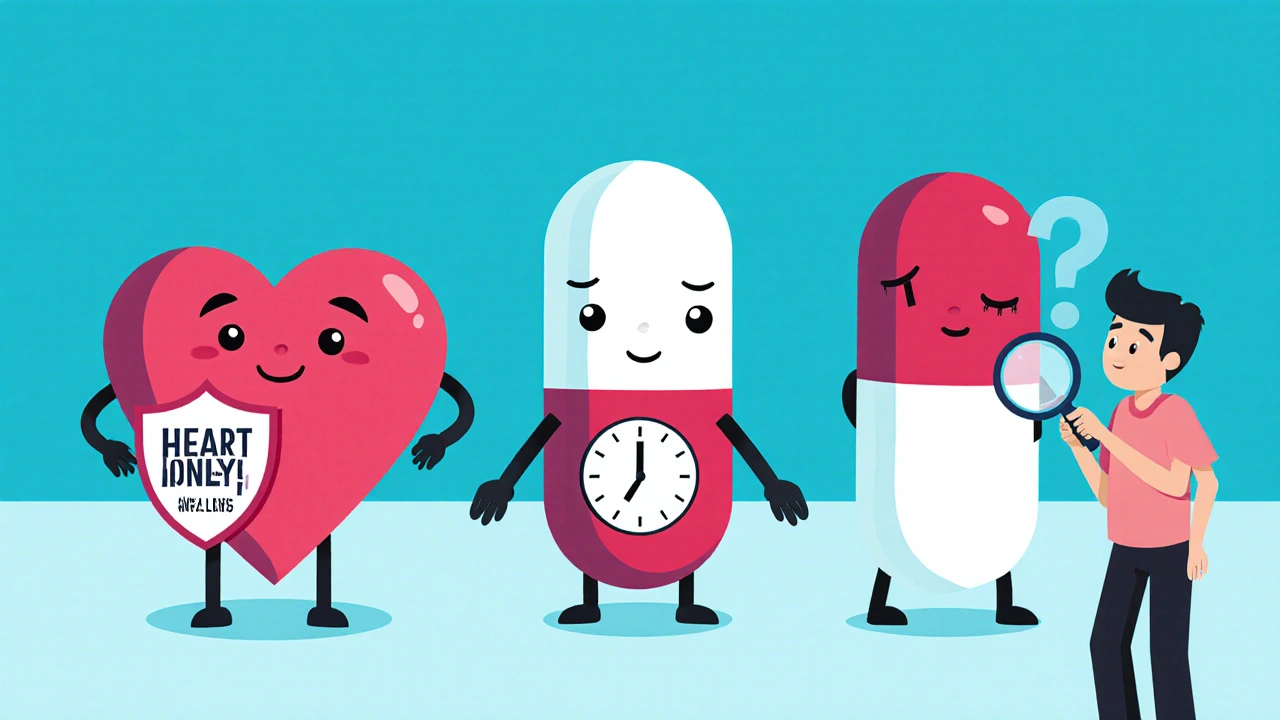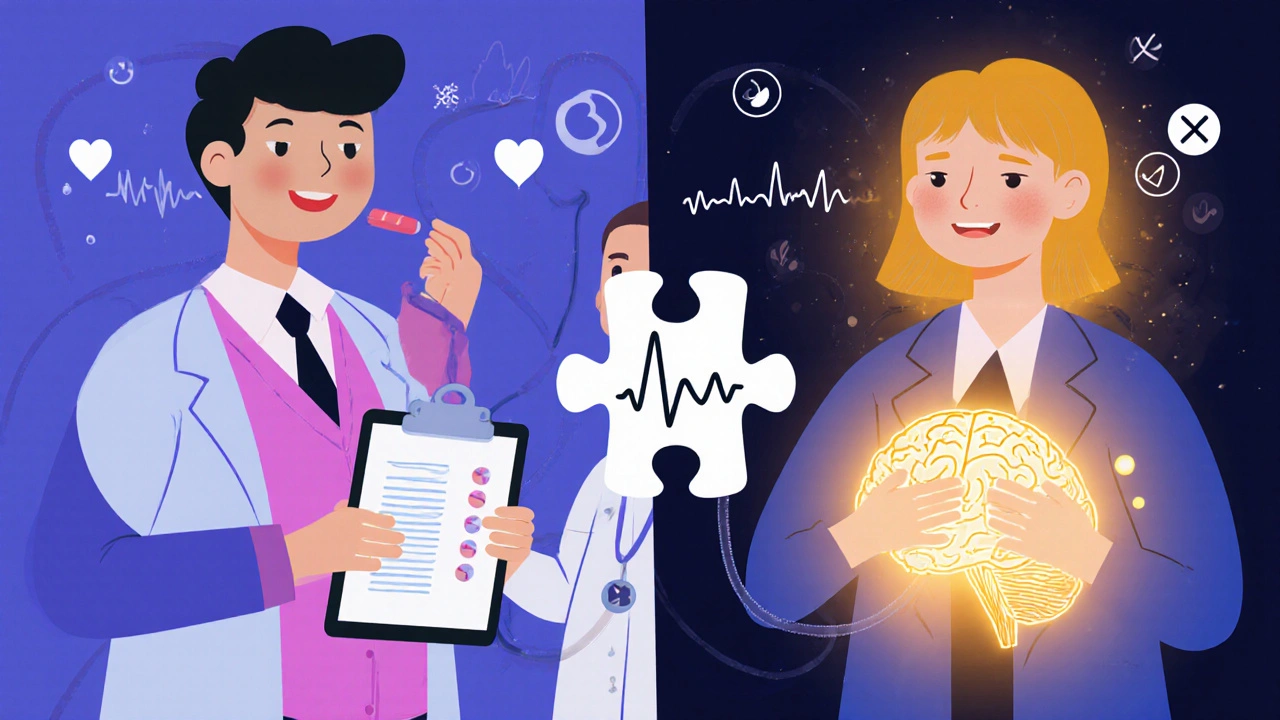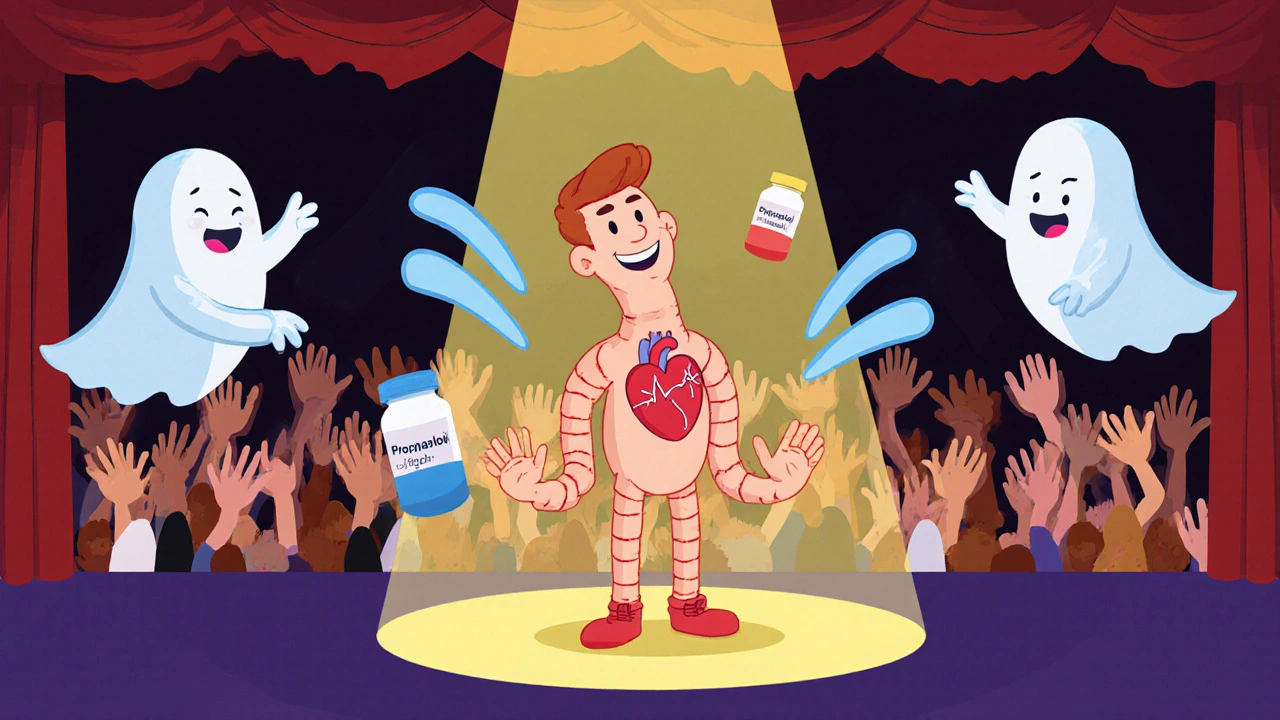Propranolol isn’t just another pill on the shelf. It’s been helping people manage heart palpitations, performance anxiety, and high blood pressure for over 50 years. But if you’ve been taking it and feel like it’s not doing enough-or you’re dealing with side effects like fatigue, dizziness, or cold hands-you’re not alone. Many people start looking for alternatives. And that’s smart. Not every beta blocker works the same way. Not every condition responds the same way either.
What Propranolol Actually Does
Propranolol is a beta blocker a non-selective beta-adrenergic receptor antagonist that reduces heart rate, lowers blood pressure, and decreases the force of heart contractions. It blocks adrenaline from binding to beta receptors in your heart, blood vessels, and even your brain. That’s why it works for more than just heart issues. It’s used off-label for anxiety, migraines, tremors, and even stage fright. It doesn’t cure anxiety-it quiets the physical symptoms: shaky hands, racing heart, sweating. For someone giving a presentation or playing a solo, that’s huge.
It’s also prescribed for essential tremor and hypertension. In heart attack recovery, it reduces the chance of another event. The typical dose for anxiety is 10-40 mg taken 30-60 minutes before the event. For high blood pressure, it’s often 80-160 mg daily in divided doses. But dosing varies widely depending on the person, their weight, liver function, and what else they’re taking.
Why People Look for Alternatives
Propranolol isn’t perfect. It’s non-selective, meaning it hits both beta-1 and beta-2 receptors. That’s why it can cause bronchoconstriction-bad news for people with asthma or COPD. It can also lower blood sugar too much, which is risky for diabetics. Fatigue and depression are common complaints. And because it crosses the blood-brain barrier, some users report vivid dreams or mood changes.
People also switch because they want something more targeted. Maybe they only need to slow their heart rate, not affect their lungs. Or they’re tired of taking pills before every public speaking gig. Others want a longer-lasting option, or something that doesn’t interfere with sleep. That’s where alternatives come in.
Atenolol: The Selective Choice
Atenolol a cardioselective beta blocker that primarily targets beta-1 receptors in the heart, with less effect on the lungs and metabolism is often the first alternative doctors suggest. Unlike propranolol, atenolol is cardioselective-it mostly sticks to the heart. That means fewer side effects in the lungs, making it safer for people with mild asthma or COPD.
It’s also longer-lasting. One daily dose is usually enough, while propranolol often needs two or three. That’s convenient. But here’s the catch: atenolol doesn’t cross the blood-brain barrier well. So if you’re using propranolol for anxiety or tremors, atenolol might not help much. It’s great for blood pressure and heart rate control, but not for performance anxiety.
People who’ve switched from propranolol to atenolol for hypertension often report fewer cold hands and less fatigue. But if your anxiety spikes before a meeting, you might feel like nothing’s changed.
Metoprolol: The Middle Ground
Metoprolol a beta-1 selective blocker available in immediate-release and extended-release forms, commonly used for hypertension, angina, and heart failure sits between propranolol and atenolol. It’s also cardioselective, but not as much as atenolol. And unlike atenolol, it does cross the blood-brain barrier-just not as strongly as propranolol.
That makes metoprolol a decent middle ground. For high blood pressure? Excellent. For anxiety? Sometimes. Many users report reduced heart racing and shaking with metoprolol, but it’s not as reliable as propranolol for stage fright. The extended-release version (metoprolol succinate) gives you steady levels all day, which helps with consistent symptom control.
One big advantage: metoprolol is less likely to cause depression than propranolol. Studies from the Journal of Clinical Hypertension in 2023 showed lower rates of mood-related side effects with metoprolol compared to non-selective beta blockers.

Propranolol vs. Nadolol: Long-Lasting but Less Flexible
Nadolol a non-selective beta blocker with a very long half-life, typically dosed once daily for hypertension and arrhythmias is another non-selective option, like propranolol. But it lasts longer-up to 24 hours. That means one pill a day, no matter what you’re using it for.
It’s often used for arrhythmias and long-term blood pressure control. But because it’s so long-acting, it’s not ideal for situational anxiety. You can’t take it just before a speech-you’d be stuck with the effects all day. That’s why it’s rarely chosen for performance anxiety.
Side effects are similar to propranolol: fatigue, dizziness, cold extremities. But some people find nadolol less likely to cause insomnia. If you’re looking for a once-daily beta blocker for chronic conditions, nadolol is worth considering. For on-demand use? Not so much.
Non-Beta Blocker Alternatives for Anxiety
Maybe you’re not looking for another beta blocker at all. Maybe you want something that tackles anxiety differently.
SSRIs selective serotonin reuptake inhibitors, such as sertraline and escitalopram, are first-line treatments for generalized anxiety disorder and social anxiety like sertraline or escitalopram are often prescribed for chronic anxiety. They don’t work fast-they take weeks-but they change how your brain handles stress long-term. Unlike propranolol, they don’t just mask symptoms. They help rewire your response. If you’re dealing with social anxiety disorder, panic attacks, or generalized worry, SSRIs are usually more effective than beta blockers.
For situational anxiety, some people turn to benzodiazepines fast-acting sedatives like lorazepam or alprazolam, used short-term for acute anxiety episodes like lorazepam or alprazolam. They work in minutes. But they’re addictive. Most doctors won’t prescribe them for more than a few weeks. They’re a bridge, not a solution.
Then there’s Buspirone a non-benzodiazepine anxiolytic that acts on serotonin receptors, used for generalized anxiety without sedation or dependence risk, a non-addictive option that’s not a beta blocker or benzodiazepine. It takes 2-4 weeks to kick in, but it doesn’t cause drowsiness or dependence. It’s not as fast as propranolol for physical symptoms, but it’s safer for long-term use.
For High Blood Pressure: Beyond Beta Blockers
If your main goal is lowering blood pressure, beta blockers aren’t always the first choice anymore. Guidelines from the American Heart Association now recommend ACE inhibitors, ARBs, calcium channel blockers, or thiazide diuretics as first-line for most patients.
Lisinopril an ACE inhibitor that relaxes blood vessels by blocking angiotensin-converting enzyme, commonly used for hypertension and heart failure is often preferred because it’s gentler on metabolism and doesn’t cause fatigue like beta blockers. It also protects the kidneys, which matters if you have diabetes. Amlodipine a calcium channel blocker that dilates arteries to reduce blood pressure, with minimal effect on heart rate is another top pick-it’s well-tolerated, doesn’t cause cold hands, and works great with or without food.
Many people switch from propranolol to amlodipine and notice immediate improvements: warmer hands, better sleep, more energy. But they lose the anxiety benefit. That’s why some end up on a combo: amlodipine for blood pressure, and propranolol only when needed for tremors or panic.

When to Stick With Propranolol
Propranolol still has unique advantages. It’s the only beta blocker proven to reduce tremors in essential tremor. It’s the go-to for performance anxiety because it works fast and directly on physical symptoms. It’s also used for migraine prevention-few other beta blockers have that approval.
If you’re a musician, a public speaker, or someone who gets physically overwhelmed by stress, propranolol might still be your best tool. The key is using it correctly: on-demand, not daily, and only when needed.
For chronic conditions like hypertension or arrhythmias, newer drugs may be safer and more effective. But for acute, situational symptoms? Propranolol hasn’t been replaced.
How to Decide What’s Right for You
There’s no one-size-fits-all. Here’s how to think about it:
- What’s your main goal? If it’s lowering blood pressure, try amlodipine or lisinopril. If it’s stage fright, stick with propranolol. If it’s daily anxiety, consider an SSRI.
- Do you have asthma or diabetes? Avoid non-selective beta blockers like propranolol or nadolol. Go for atenolol or metoprolol.
- Do you need fast relief or long-term change? Propranolol and benzodiazepines work fast. SSRIs and buspirone take weeks.
- Are you worried about side effects? Metoprolol has fewer mood effects than propranolol. Atenolol causes less fatigue.
Many people end up on a combination. One pill for daily blood pressure, another for occasional anxiety. That’s not failure-it’s smart management.
What to Watch Out For
Never stop propranolol cold turkey. Abruptly stopping can cause rebound high blood pressure, chest pain, or even a heart attack. Always taper under a doctor’s supervision.
Also, watch for interactions. Propranolol can boost the effects of insulin or diabetes meds. It can make antidepressants less effective. And it shouldn’t be mixed with certain asthma inhalers or anti-inflammatory drugs.
Keep a symptom journal. Note when you take your medication, what you’re doing, and how you feel. That’s the best way to figure out what’s working-and what’s not.
Is propranolol better than atenolol for anxiety?
Yes, for situational anxiety like public speaking or performance nerves. Propranolol crosses the blood-brain barrier and directly reduces physical symptoms like shaking and rapid heartbeat. Atenolol doesn’t cross the barrier well, so it’s less effective for anxiety-even though it’s just as good for blood pressure.
Can I switch from propranolol to metoprolol myself?
No. Switching beta blockers requires careful dosing and timing. Metoprolol isn’t a direct 1:1 substitute. Your doctor will calculate the right dose based on your condition and current propranolol dose. Stopping suddenly can be dangerous.
Are there natural alternatives to propranolol for anxiety?
Some people use magnesium, L-theanine, or adaptogens like ashwagandha to help with mild anxiety symptoms. But none have the same rapid, reliable effect on physical symptoms as propranolol. They may help with overall calmness, but won’t stop a racing heart before a presentation.
Why do some doctors no longer prescribe beta blockers for high blood pressure?
Guidelines changed because studies showed beta blockers are less effective at preventing strokes than other drugs like ACE inhibitors or calcium channel blockers. They also cause more side effects like fatigue and weight gain. So now, they’re usually reserved for people with heart conditions, not just high blood pressure alone.
Does propranolol cause weight gain?
Yes, it can. Beta blockers slow metabolism and may reduce physical activity due to fatigue. People often gain 1-3 kg in the first few months. If weight gain is a concern, alternatives like amlodipine or lisinopril are less likely to cause this side effect.
Next Steps
If you’re thinking about switching from propranolol, talk to your doctor. Bring your symptom journal. Ask: "What’s my main goal?" and "What side effects matter most to me?"
There’s no shame in outgrowing a medication. What worked a year ago might not be the best fit now. The goal isn’t to stay on the same pill forever-it’s to feel better, safely and consistently.


Post A Comment